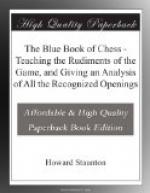[Footnote A: A favorite move with several of the strongest of modern players.]
[Footnote B: If White take P. with P., the Black K. B. is brought into play; and if not, the advance of P. to B’s 5th is threatened.]
[Footnote C: Chiefly to double White’s Pawns.]
[Footnote D: Black foresaw the intended attack on the B. P., and by providing for it in this way brought another Piece into action.]
[Footnote E: White keeps up the attack on the B. P. with a great deal of vigor. The move of R. P. two was a very good one.]
[Footnote F: The best move.]
[Footnote G: The R. is well posted—for attack and defence.]
[Footnote H: Black has now resumed the offensive.]
[Footnote I: Threatening to take Q. if P. takes P., and attacking Q. R. at the same time. There was still another motive for this move, viz.: to induce White to take R. P., foreseeing the R. would be lost subsequently.]
[Footnote J: To enslave the Rook.]
[Footnote K: An excellent move. In this and the succeeding moves, White played very well. His efforts were directed to saving his R., but, as the result showed, without success.]
[Footnote L: Apparently hazardous, but justified by the gain of time.]
[Footnote M: We believe his best move.]
[Footnote N: White was obliged to lose the exchange, although he fought manfully against it.]
[Footnote O: Another very good move in White.]
[Footnote P: Black’s advantage in the exchange begins now to tell on the game.]




